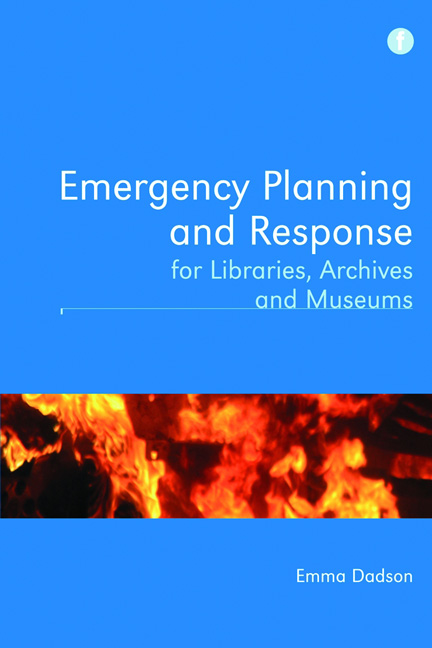Book contents
- Frontmatter
- Contents
- Foreword
- Preface
- Acknowledgements
- 1 Introduction
- 2 Case studies
- 3 Roles and responsibilities
- 4 Incident control
- 5 Planning the recovery operation
- 6 Collections salvage
- 7 Supplementary content
- 8 Dealing with the building
- 9 Business continuity
- 10 Ensuring the plan's efficacy
- 11 Conclusion
- Bibliography and references
- Index
- Frontmatter
- Contents
- Foreword
- Preface
- Acknowledgements
- 1 Introduction
- 2 Case studies
- 3 Roles and responsibilities
- 4 Incident control
- 5 Planning the recovery operation
- 6 Collections salvage
- 7 Supplementary content
- 8 Dealing with the building
- 9 Business continuity
- 10 Ensuring the plan's efficacy
- 11 Conclusion
- Bibliography and references
- Index
Summary
A medical records store with unique, irreplaceable patient information in hard copy; a national museum whose galleries and stores are brimming with items of cultural significance; a public record office, home to a unique historical archive; a law firm, with wills and property deeds in its strongroom; a university library, an essential tool for students and academic staff in their studies and research: these institutions include library, archive and museum services, together with historic houses, but also encompass those engaged in the information services field such as records management services. All differ in scale, their core mission, staffing and clientbase, but are linked by the potential impact of an emergency incident such as a fire or flood affecting the collections they store. Objects may either be unique, culturally significant or extremely financially valuable, and therefore impossible or extremely costly to replace. In the case of records and modern library collections, damage or destruction of these items may significantly disrupt service provision, threaten significant reputational damage or breach regulatory requirements.
Emergency response must be prompt, well organized and competent in order to protect collections, facilitating salvage and restoration at the earliest opportunity. The question is whether it is necessary to have a plan for such an emergency to ensure an adequate response. Can professional, capable individuals source the solutions required dynamically on the day to minimize damage without preparation? In an age where an internet search will list a dozen plumbers who would be able to repair a leaking pipe, or find websites detailing procedures for dealing with wet microfiche, is an emergency plan redundant? Surely common sense, a phone and internet access is all that is needed to resolve problems as they emerge on the day?
Why is a plan important?
More effective response through pre-incident planning
Experiences from countless emergency salvage operations in such institutions indicate that disaster recovery is anything but straightforward. Preincident preparation is critical to maximize the success of salvage if the limited time after the incident before which existing damage will rapidly deteriorate can be used to greatest effect. Failure to respond quickly to an incident involving leaking of water, and organize staff and equipment to control and isolate the source of the damage, will potentially result in a leak of a longer duration, resulting in a much larger overall quantity of damaged material, which could have been avoided through quicker action.
- Type
- Chapter
- Information
- Publisher: FacetPrint publication year: 2012



